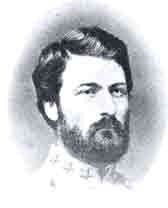 |
| NPS Image | | George Washington Custis Lee |
 |
Born in 1832, Custis (or "Boo," "Bunny," etc.) was the oldest of the Lees' children and had the reputation of a trouble maker as a small child. But he grew up to be a serious, and most capable young man and graduated at the top of his class from the United States Military Academy in 1854. After graduation, Custis pursued a military career.
There appears to be less information on his personal habits and tastes than about some of the other members of the family. He was a fine horseman, though not the equal of his younger brother Rooney. Studious and painfully shy in the company of women, he never married. Photographs show him to have been tall and handsome, with dark hair. He rather resembled his father.
Letters to him from his parents suggest that he took part in family activities and was warmly regarded by his brothers and sisters. He was certainly generous and devoted to them. As the eldest son, he was to inherit Arlington at his mother's death, but did not seem interested in running the estate and offered to surrender his share of Arlington to his father in 1858.
In May 1861, Custis resigned his commission in the U.S. Army shortly after Virginia voted to secede from the Union. During the Civil War he attained the rank of Brigadier General, C.S.A., serving as aide-de-camp to President Jefferson Davis of the Confederacy. Though Custis spent most of the war working in Davis's office, he volunteered to take his younger brother Rooney's place as a prisoner of war so that Rooney could come home to be with his dying wife in 1863. After the war he was a professor of military science and engineering at Virginia Military Institute, and in 1871 succeeded his late father as President of Washington College (now Washington & Lee University).
Following the death of his mother, in 1873, Custis brought suit against the U.S. Government in hopes of gaining compensation for Arlington after its seizure during the Civil War. After a long court battle, the United States Supreme Court ruled that Arlington had been illeagally seized and Custis regained title to the property. Knowing that he could not live at Arlington and operate it as a plantation estate, he sold the title back to the U.S. Government for $150,000.
Custis Lee died at Ravensworth in Fairfax County, Virginia in 1913. His association with the rooms at Arlington was primarily with the boys' chamber upstairs and with what Mrs. Lee in 1861, called his "office," presumably the end room in the south wing.
|







